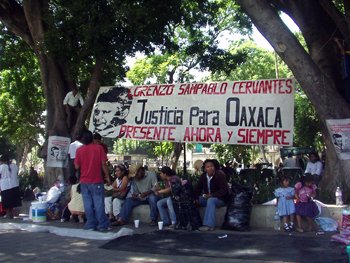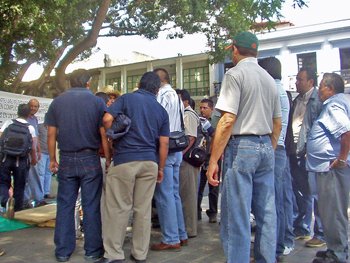


The Real Battle for Oaxaca: Who is Permitted to Earn Money, and Where?
"The lesser officials manage the street scene, but also the professionals, vendor bosses, who run a crew of ten or a dozen"
By Nancy Davies
Commentary from Oaxaca
August 17, 2009
A plague of ambulatory vendors annoy the tourists sipping cappuccinos in the Oaxaca zócalo. Beneath the cafe umbrellas vacationers, often with their families, don’t want to be pestered. They have disposable money; smart vendors head for the “whities”. The peddlers, here called ambulantes, have changed. A decade ago I could greet the same few — a family who sells homemade candy, Jorge who sells rebozos, AltaGracia who sells place-mats and table runners—all “inherited” their peddler’s licenses from parents, or so they tell me. During 2006, they suffered —no tourists, no sales. AltaGracia, a vital woman with a nice smile, lost almost all her teeth in the past two years.
 Vendors waiting for permission D.R. 2009 – Photos Nancy Davies |
On the corners the sellers of raspas station their ice-carts, and the popsicle vendors and soda vendors criss-cross the square.
Stationary vendors descend for any and all fiestas, to set up on the sidewalks their blouses and “hand-made” tourist goods, tortillas and comals for cooking food, oil cloth covered tables and iron benches or stools -a carnival atmosphere. In the background the blaring music. The permanent puestos (the booths which might or might not be taken down at night) smothered Bustamante Street, supplemented by sidewalk vendors with lettuce and radishes and fruits in season. Las Casas Street has been jammed for so long that I think of it as my favorite street, for its “true to life” confusion. The shopkeepers complain, probably with good reason —there’s hardly space to enter.
Welcome to hard times. The slippage of the Oaxaca (and Mexican) economy can be calculated by the numbers of vendors multiplied by the number of fiestas. Certain streets adjacent to the zócalo filled with booths. Lots of nail polish and pirated music. Socks. T shirts. Cheap anything you can imagine. Further south, boys and girls selling sex. On the north, beggars seated on the sidewalks with their sleeping toddlers, (maybe) drugged to keep them quiet for the twelve-hour day. I can’t verify that. The man and woman who hold a cup while the guy plays the accordion have children who stay awake.
Puestos block access to “legitimate” stores. The commercial people complained again, more loudly. Last week the police arrived with riot gear. One cop kicked the merchandise of a woman who wouldn’t budge. A scuffle broke out. Jim (elderly American wreck) told me he “was going to say something to the cop but then didn’t, I thought I might get deported.” The cop wrestled away the woman with her arm wrenched up behind her.
The Next Week Vendors Seemed to Know the Rules
But not everyone. The APPO vendors believe they have a right to occupy space on the side of the cathedral, sidewalks not blocking any cafes. The month of August initiates the series of memorials for the assassinated; we’ve passed only one of the twenty-three. The vendors arrived before the march, and planned to set up when the demonstrators entered the square. The cops received such bad publicity last week that they lurked under the arches of the museum ex-government palace, or on the Alameda. Some posed fully armed, with riot shields. I took photos of a cop taking photos of me.
 |
When the negotiations for space ended, all the government guys left. The vendors hefted their babies and hand-trolleys of wares, and set them down on the street intersecting the zócalo, well within tourist range. Whew. No scuffle. The government does not want another public scuffle. Only, as one blond twenty-something from the USA asked me, “Why are there so many police and military here?”
Well, Kim, I say, in Oaxaca cops loiter everywhere. And everyone’s gotta earn a living. In Oaxaca’s past, its governors never invested in any industry other than tourism. Income from remittances filled some gaps, and for those in power, corruption did the same. Now drugs, foreign investments in mining and wind-power provide a source of income by percentage points to those in power —certainly not to ordinary people. NAFTA made farming less profitable, and the government talks about supporting the campesinos and does not, although money came from the federal government.
Authorities permit an increase in street vending, which provides them another base for corruption. Government jobs circulate in a very closed sphere. The lesser officials manage the street scene, but also the professionals, vendor bosses, who run a crew of ten or a dozen. How is one to know who vends out of genuine need, or who has two or three puestos? Or rents their concessions like private businesses?
 |
Oaxaca is not the only city facing times of crisis. Vending requires a very small investment. It provides immediate employment where no jobs exist. Furthermore, some tourists enjoy the scene: venders, artisans, cooking tortillas. The government imposes few taxes —problems reside with the license bribes.
But the scene vibrates with noise, smells, dirt and probable risk for health and well-being. It’s pretty near impossible for the elderly and wheel-chair users to get through jammed spaces. To make sense of the mess, there would have to be coordinated action in the city with no corruption, no bandit bosses, no vending without licenses, and no cops free-lancing permissions. All this plays out against the enormous salaries of government officials, the modest incomes (6,000 pesos per month) of teachers, and the minimum laborer’s wage of 53 pesos per day. The federal government admits a shrinking national income. The government of Oaxaca may be bankrupt.
[1] Noticias, August 16, 2009
Click here for more Narco News coverage of Mexico
- The Fund for Authentic Journalism
For more Narco News, click here.




